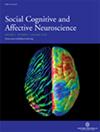The SocialVidStim: a video database of positive and negative social evaluation stimuli for use in social cognitive neuroscience paradigms
IF 3.1
2区 医学
Q2 NEUROSCIENCES
引用次数: 0
Abstract
This paper describes the SocialVidStim—a database of video stimuli available to the scientific community depicting positive and negative social evaluative and neutral statements. The SocialVidStim comprises 53 diverse individuals reflecting the demographic makeup of the USA, ranging from 9 to 41 years old, saying 20–60 positive and 20–60 negative social evaluative statements (e.g. ‘You are a very trustworthy/annoying person’), and 20–60 neutral statements (e.g. ‘The sky is blue’), totaling 5793 videos post-production. The SocialVidStim are designed for use in behavioral and functional magetic resonance imaging paradigms, across developmental stages, in diverse populations. This study describes stimuli development and reports initial validity and reliability data on a subset videos (N = 1890) depicting individuals aged 18–41 years. Raters perceive videos as expected: positive videos elicit positively valenced ratings, negative videos elicit negatively valenced ratings and neutral videos are rated as neutral. Test–retest reliability data demonstrate intraclass correlations in the good-to-excellent range for negative and positive videos and the moderate range for neutral videos. We also report small effects on valence and arousal that should be considered during stimuli selection, including match between rater and actor sex and actor believability. The SocialVidStim is a resource for researchers and we offer suggestions for using the SocialVidStim in future research.SocialVidStim:用于社会认知神经科学范式的正面和负面社会评价刺激视频数据库
本文介绍了 SocialVidStim--一个可供科学界使用的视频刺激数据库,其中描述了正面和负面的社会评价和中性语句。SocialVidStim 由 53 名反映美国人口构成的不同个体组成,年龄从 9 岁到 41 岁不等,他们分别说了 20-60 句正面和 20-60 句负面的社会评价语句(如 "你是一个非常值得信赖/讨厌的人"),以及 20-60 句中性语句(如 "天空是蓝色的"),共制作了 5793 个视频。SocialVidStim 设计用于不同人群不同发育阶段的行为和功能磁共振成像范例。本研究介绍了刺激物的开发,并报告了描述 18-41 岁个体的子集视频(N = 1890)的初步有效性和可靠性数据。评分者对视频的感知符合预期:积极的视频会引起积极的评价,消极的视频会引起消极的评价,中性的视频会被评为中性。测试-再测可靠性数据表明,负面和正面视频的类内相关性在良好-优秀范围内,中性视频的类内相关性在中等范围内。我们还报告了在选择刺激物时应考虑的对情绪和唤醒的微小影响,包括评分者和演员性别之间的匹配以及演员的可信度。SocialVidStim 是研究人员的一种资源,我们为在未来研究中使用 SocialVidStim 提出了建议。
本文章由计算机程序翻译,如有差异,请以英文原文为准。
求助全文
约1分钟内获得全文
求助全文
来源期刊
CiteScore
6.80
自引率
4.80%
发文量
62
审稿时长
4-8 weeks
期刊介绍:
SCAN will consider research that uses neuroimaging (fMRI, MRI, PET, EEG, MEG), neuropsychological patient studies, animal lesion studies, single-cell recording, pharmacological perturbation, and transcranial magnetic stimulation. SCAN will also consider submissions that examine the mediational role of neural processes in linking social phenomena to physiological, neuroendocrine, immunological, developmental, and genetic processes. Additionally, SCAN will publish papers that address issues of mental and physical health as they relate to social and affective processes (e.g., autism, anxiety disorders, depression, stress, effects of child rearing) as long as cognitive neuroscience methods are used.

 求助内容:
求助内容: 应助结果提醒方式:
应助结果提醒方式:


